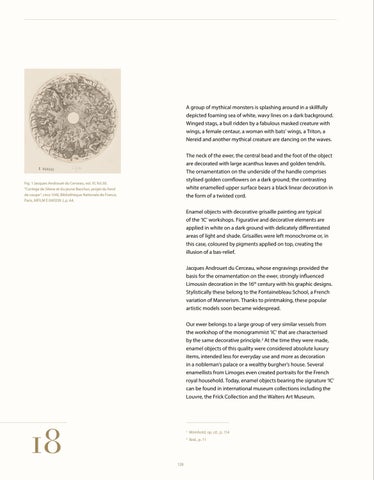A group of mythical monsters is splashing around in a skillfully depicted foaming sea of white, wavy lines on a dark background. Winged stags, a bull ridden by a fabulous masked creature with wings, a female centaur, a woman with bats’ wings, a Triton, a Nereid and another mythical creature are dancing on the waves. The neck of the ewer, the central bead and the foot of the object are decorated with large acanthus leaves and golden tendrils. The ornamentation on the underside of the handle comprises stylised golden cornflowers on a dark ground; the contrasting white enamelled upper surface bears a black linear decoration in the form of a twisted cord.
Fig. 1 Jacques Androuet du Cerceau, vol. VI, fol.30. ”Cortège de Silene et du jeune Bacchus, projet du fond de coupe“, circa 1546, Bibliothèque Nationale de France, Paris, MFILM E 040339. L.p. 64.
Enamel objects with decorative grisaille painting are typical of the ‘IC’ workshops. Figurative and decorative elements are applied in white on a dark ground with delicately differentiated areas of light and shade. Grisailles were left monochrome or, in this case, coloured by pigments applied on top, creating the illusion of a bas-relief. Jacques Androuet du Cerceau, whose engravings provided the basis for the ornamentation on the ewer, strongly influenced Limousin decoration in the 16th century with his graphic designs. Stylistically these belong to the Fontainebleau School, a French variation of Mannerism. Thanks to printmaking, these popular artistic models soon became widespread. Our ewer belongs to a large group of very similar vessels from the workshop of the monogrammist ‘IC’ that are characterised by the same decorative principle.2 At the time they were made, enamel objects of this quality were considered absolute luxury items, intended less for everyday use and more as decoration in a nobleman’s palace or a wealthy burgher’s house. Several enamellists from Limoges even created portraits for the French royal household. Today, enamel objects bearing the signature ‘IC’ can be found in international museum collections including the Louvre, the Frick Collection and the Walters Art Museum.
18
128
1
Weinhold, op. cit., p. 114
2
Ibid., p. 11

























